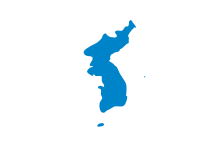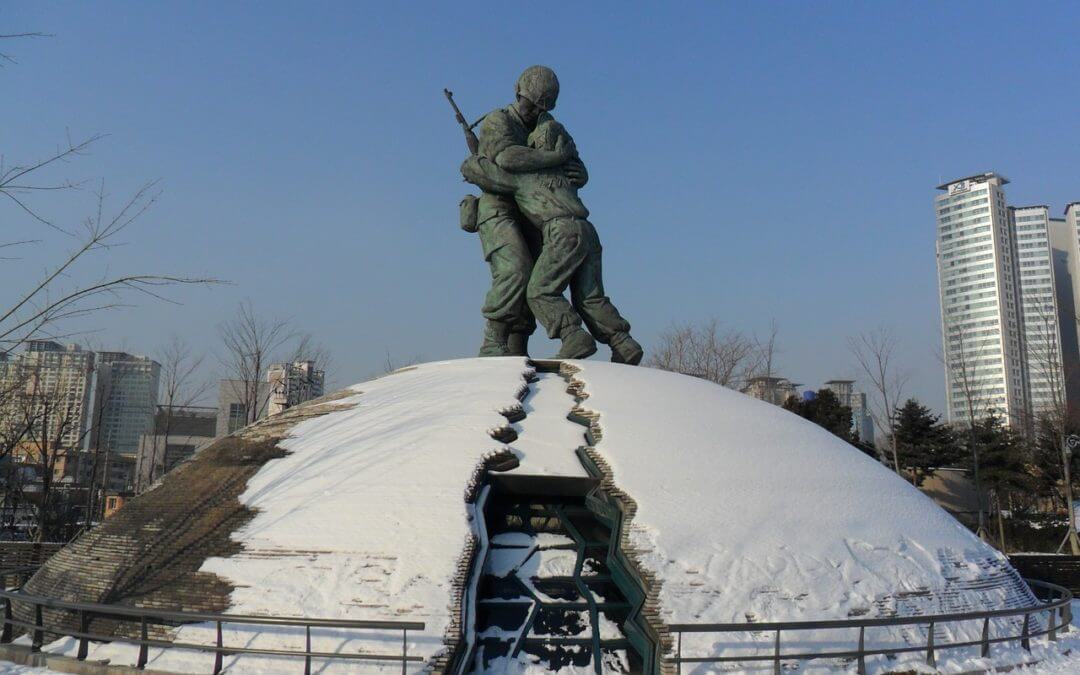Since its annexation by the Japanese government in 1910, the Korean people have longed to build a free, united, and independent homeland. Today, the continued division of the peninsula has also obscured Korea’s founding vision of Hongik Ingan, which was to establish a nation that can “benefit all humanity.”
Throughout that dark period of colonization to liberation, and then, tragically, the division of the Korean peninsula in 1945, patriots from Ahn Chang Ho to Kim Gu and many others have worked to harken back to this ideal.
Today, Action for Korea United (AKU), the largest civil society-based coalition of groups across the Korean peninsula takes up the vision and the spirit of the Korean Independence movement to fulfill the Korean Dream of Hongik Ingan. The following is a timeline of critical dates related to the occupation and division of the Korean peninsula.

The Unification flag was created to represent North and South Korean representation in international sporting events.
Timeline of the Division of North and South Korea
Annexation
1905 Japan wins the Russo-Japanese War
1910 Japan formally annexes Korea
End of World War I and Independence Movements
1919 March 1 Declaration of Korean Independence begins a peninsula-wide movement for independence, engaging 2 million Koreans (10% of the population). The movement died down without attaining Korean independence but resulted in sustained independence efforts by Koreans abroad. During this time, small ideological differences would become apparent, deepening as time passed.
1919 April 13 the Korean Provisional Government was established in China by Koreans who had moved to China, nominally supported by the Chinese National Government. It tried unsuccessfully to attend the Paris Peace Conference at the end of World War I to bring up the issue of Korean independence.
1919 April the First Korean Congress was held in Philadelphia with Koreans in the U.S. like Syngman Rhee and Philip Jaisohn. This would be the beginning of ongoing efforts of Koreans in the United States to seek support for Korean independence from the United States.
End of World War II and Independence Efforts
1943 December Cairo Conference – the U.S., China, and Great Britain recognize the “enslavement of the people of Korea,” and “determine that in due course Korea shall become free and independent.” Many nations, including the U.S., did not deem Koreans ready for self-governance. A trusteeship was proposed.
1945 August 17 Japan surrenders in WWII.
1945 September 6 After months of organizing people’s committees under the Committee for the Preparation of Korean Independence. The People’s Republic of Korea was recognized by a congress of local representatives.
Trusteeship
1945 December At the Moscow Conference, Allies agreed to a U.S. proposal for a 5-year trusteeship over Korea dividing the peninsula along the 38th parallel. The Soviet Union would monitor a transition of the territory in the north, and the U.S. would monitor the south.
1946-1947 A Soviet-U.S. Joint Commission meets to work towards a unified administration, but Cold War tensions, as well as Korean sentiments against a trusteeship, which was thought to hinder progress towards self-governance.
1947 November 14 The UN passes a resolution for free elections to be held in Korea and a withdrawal of all foreign troops. The UN established the United Nations Temporary Commission on Korea (UNTCOK). The Soviet Union boycotted the vote.
1948 April conference for North and South meet in Pyongyang to discuss how to mitigate rising tensions. Southern representatives Kim Koo and Kim Hyu-sik attend, pushing for unity. The conference does not produce results.
Establishment of the Republic of Korea (South) and the Democratic People’s Republic of Korea (North)
1948 May 10 South Korea holds general elections.
1948 August 15 South Korea establishes the “Republic of Korea,” formally taking over power from the U.S. military, and electing Syngman Rhee as its first president.
1948 August 20 North Korea holds elections.
1948 September 9 North Korea declares the Democratic People’s Republic of Korea, with Kim Il-sung as its premier.
1948 December 12 the United Nations General Assembly recognized the Republic of Korea as the only lawful government of Korea.
Korean War
1948-1950 Armed forces, South and North engage in border conflicts.
1950 June 25 North Korean forces invade South Korea, starting the Korean War. China and the Soviet Union supported the DPRK in their efforts to unify the peninsula by force.
1950 June 27 the UN Security Council passed Resolution 83 recommending member states to provide military assistance to South Korea. UN Forces would include 28 nations, the largest forces from the United States.
Armistice
1953 July 27 After 2 years of negotiations, an armistice agreement was finally reached, dividing Korea along the 38th parallel, yet again. Although the armistice agreement included a provision for continued peace talks, there has not yet been a final peace accord that would officially end the war. 2.5 million deaths are recorded in the Korean War. North and South Korea remain divided for over 70 years.
Revised March 8, 2018

